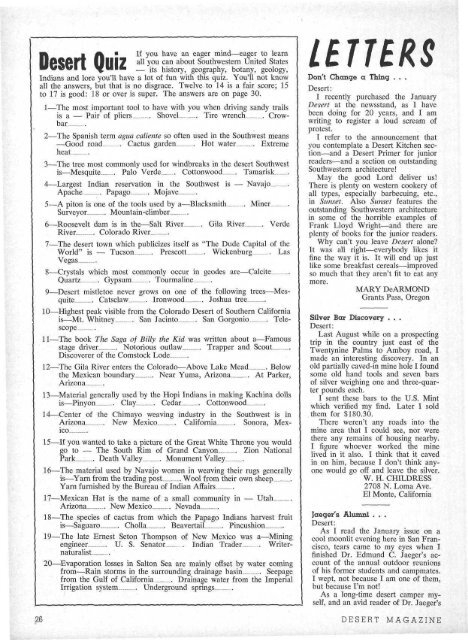Desert Book - Desert Magazine of the Southwest
Desert Book - Desert Magazine of the Southwest
Desert Book - Desert Magazine of the Southwest
Create successful ePaper yourself
Turn your PDF publications into a flip-book with our unique Google optimized e-Paper software.
Quiz<br />
If you have an eager mind—eager to learn<br />
all you can about <strong>Southwest</strong>ern United States<br />
— its history, geography, botany, geology,<br />
Indians and lore you'll have a lot <strong>of</strong> fun with this quiz. You'll not know<br />
all <strong>the</strong> answers, but that is no disgrace. Twelve to 14 is a fair score; 15<br />
to 17 is good: 18 or over is super. The answers are on page 30.<br />
1—The most important tool to have with you when driving sandy trails<br />
is a — Pair <strong>of</strong> pliers Shovel Tire wrench Crowbar<br />
2—The Spanish term agua caliente so <strong>of</strong>ten used in <strong>the</strong> <strong>Southwest</strong> means<br />
—Good road Cactus garden Hot water Extreme<br />
heat<br />
3—The tree most commonly used for windbreaks in <strong>the</strong> desert <strong>Southwest</strong><br />
is—Mesquite Palo Verde Cottonwood Tamarisk<br />
4—Largest Indian reservation in <strong>the</strong> <strong>Southwest</strong> is — Navajo<br />
Apache Papago Mojave<br />
5—A piton is one <strong>of</strong> <strong>the</strong> tools used by a—Blacksmith Miner<br />
Surveyor Mountain-climber<br />
6—Roosevelt dam is in <strong>the</strong>—Salt River Gila River Verde<br />
River _„. Colorado River<br />
7—The desert town which publicizes itself as "The Dude Capital <strong>of</strong> <strong>the</strong><br />
World" is — Tucson Prescott Wickenburg Las<br />
Vegas<br />
8—Crystals which most commonly occur in geodes are—Calcite<br />
Quartz .-. Gypsum Tourmaline<br />
9—<strong>Desert</strong> mistletoe never grows on one <strong>of</strong> <strong>the</strong> following trees—Mesquite<br />
Catsclaw Ironwood Joshua tree<br />
10—Highest peak visible from <strong>the</strong> Colorado <strong>Desert</strong> <strong>of</strong> Sou<strong>the</strong>rn California<br />
is—Mt. Whitney San Jacinto San Gorgonio Telescope<br />
11—The book The Saga <strong>of</strong> Billy <strong>the</strong> Kid was written about a—Famous<br />
stage driver Notorious outlaw Trapper and Scout<br />
Discoverer <strong>of</strong> <strong>the</strong> Comstock Lode<br />
12—The Gila River enters <strong>the</strong> Colorado—Above Lake Mead Below<br />
<strong>the</strong> Mexican boundary Near Yuma, Arizona At Parker,<br />
Arizona<br />
13—Material generally used by <strong>the</strong> Hopi Indians in making Kachina dolls<br />
is—Pinyon Clay Cedar Cottonwood<br />
14—Center <strong>of</strong> <strong>the</strong> Chimayo weaving industry in <strong>the</strong> <strong>Southwest</strong> is in<br />
Arizona New Mexico California Sonora, Mexico<br />
15—If you wanted to take a picture <strong>of</strong> <strong>the</strong> Great White Throne you would<br />
go to — The South Rim <strong>of</strong> Grand Canyon Zion National<br />
Park •„. Death Valley Monument Valley<br />
16—The material used by Navajo women in weaving <strong>the</strong>ir rugs generally<br />
is—Yarn from <strong>the</strong> trading post Wool from <strong>the</strong>ir own sheep<br />
Yarn furnished by <strong>the</strong> Bureau <strong>of</strong> Indian Affairs<br />
17—Mexican Hat is <strong>the</strong> name <strong>of</strong> a small community in — Utah<br />
Arizona New Mexico Nevada<br />
18—The species <strong>of</strong> cactus from which <strong>the</strong> Papago Indians harvest fruit<br />
is—Saguaro Cholla Beavertail Pincushion<br />
19—The late Ernest Seton Thompson <strong>of</strong> New Mexico was a—Mining<br />
engineer „. U. S. Senator Indian Trader Writernaturalist<br />
20—Evaporation losses in Salton Sea are mainly <strong>of</strong>fset by water coming<br />
from—Rain storms in <strong>the</strong> surrounding drainage basin Seepage<br />
from <strong>the</strong> Gulf <strong>of</strong> California Drainage water from <strong>the</strong> Imperial<br />
Irrigation system Underground springs<br />
UTTERS<br />
Don't Change a Thing . . .<br />
<strong>Desert</strong>:<br />
I recently purchased <strong>the</strong> January<br />
<strong>Desert</strong> at <strong>the</strong> newsstand, as I have<br />
been doing for 20 years, and I am<br />
writing to register a loud scream <strong>of</strong><br />
protest.<br />
I refer to <strong>the</strong> announcement that<br />
you contemplate a <strong>Desert</strong> Kitchen section—and<br />
a <strong>Desert</strong> Primer for junior<br />
readers—and a section on outstanding<br />
<strong>Southwest</strong>ern architecture!<br />
May <strong>the</strong> good Lord deliver us!<br />
There is plenty on western cookery <strong>of</strong><br />
all types, especially barbecuing, etc.,<br />
in Sunset. Also Sunset features <strong>the</strong><br />
outstanding <strong>Southwest</strong>ern architecture<br />
in some <strong>of</strong> <strong>the</strong> horrible examples <strong>of</strong><br />
Frank Lloyd Wright—and <strong>the</strong>re are<br />
plenty <strong>of</strong> books for <strong>the</strong> junior readers.<br />
Why can't you leave <strong>Desert</strong> alone?<br />
It was all right—everybody likes it<br />
fine <strong>the</strong> way it is. It will end up just<br />
like some breakfast cereals—improved<br />
so much that <strong>the</strong>y aren't fit to eat any<br />
more.<br />
MARY DeARMOND<br />
Grants Pass, Oregon<br />
Silver Bar Discovery . . .<br />
<strong>Desert</strong>:<br />
Last August while on a prospecting<br />
trip in <strong>the</strong> country just east <strong>of</strong> <strong>the</strong><br />
Twentynine Palms to Amboy road, I<br />
made an interesting discovery. In an<br />
old partially caved-in mine hole I found<br />
some old hand tools and seven bars<br />
<strong>of</strong> silver weighing one and three-quarter<br />
pounds each.<br />
I sent <strong>the</strong>se bars to <strong>the</strong> U.S. Mint<br />
which verified my find. Later I sold<br />
<strong>the</strong>m for $180.30.<br />
There weren't any roads into <strong>the</strong><br />
mine area that I could see, nor were<br />
<strong>the</strong>re any remains <strong>of</strong> housing nearby.<br />
I figure whoever worked <strong>the</strong> mine<br />
lived in it also. I think that it caved<br />
in on him, because I don't think anyone<br />
would go <strong>of</strong>f and leave <strong>the</strong> silver.<br />
W. H. CHILDRESS<br />
2708 N. Loma Ave.<br />
El Monte, California<br />
Jaeger's Alumni . . .<br />
<strong>Desert</strong>:<br />
As I read <strong>the</strong> January issue on a<br />
cool moonlit evening here in San Francisco,<br />
tears came to my eyes when I<br />
finished Dr. Edmund C. Jaeger's account<br />
<strong>of</strong> <strong>the</strong> annual outdoor reunions<br />
<strong>of</strong> his former students and campmates.<br />
I wept, not because I am one <strong>of</strong> <strong>the</strong>m,<br />
but because I'm not!<br />
As a long-time desert camper myself,<br />
and an avid reader <strong>of</strong> Dr. Jaeger's<br />
26 DESERT MAGAZINE

















